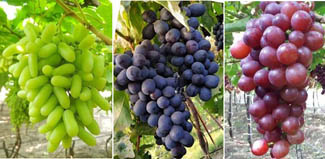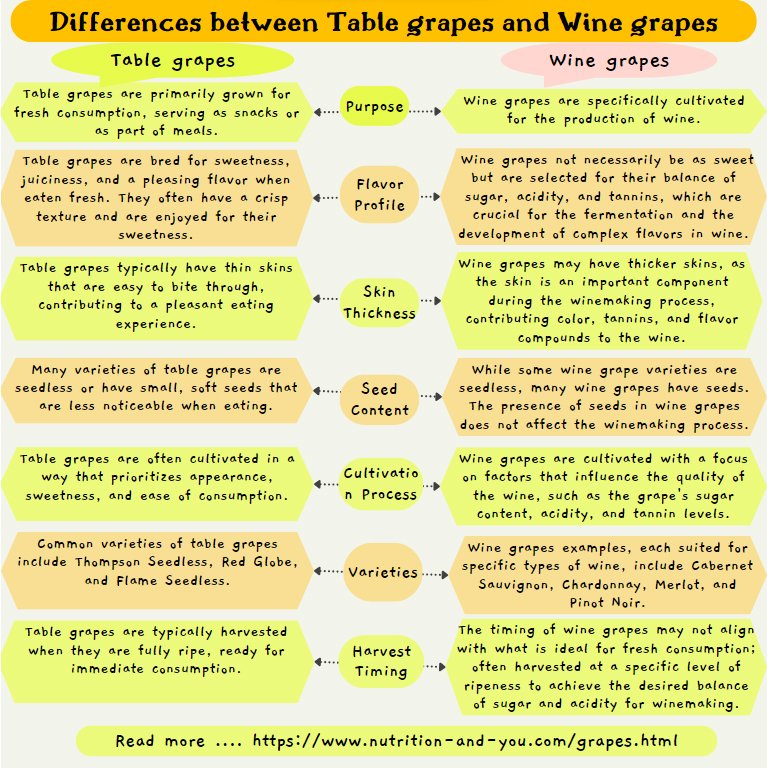Grapes Nutrition facts
Grapes, one of the most popular table fruits, have long been celebrated as the “Queen of Fruits” for their exceptional nutritional value.
These small berries, native to Europe and the Mediterranean, are rich in health-promoting phytonutrients such as polyphenolic antioxidants, vitamins, and minerals. It’s no wonder they are a staple in our diets—whether enjoyed fresh, dried as raisins, juiced, or tossed into salads.
Botanically, grapes are small, round berries that grow in clusters on perennial, deciduous woody vines belonging to the genus Vitis. Today, they are extensively cultivated in orchards and vineyards around the world.
 |
| White/green, Blue/black, and Red/purple cultivar types. |
Structurally, each grape berry consists of semi-translucent flesh enclosed within a smooth, thin skin. Some varieties contain edible seeds, while others are seedless. The color of the berries is determined by the presence of polyphenolic pigments: red or purple grapes are rich in anthocyanins, while white-green grapes contain more tannins, particularly catechin. Interestingly, these antioxidant compounds are most densely concentrated in the skin and seeds
The three most important species of table-grapes grown around the world are; European (Vitis vinifera), North American (Vitis labrusca, and Vitis rotundifolia), and French hybrids.
Some of the popular green cultivars are Thompson seedless, sugarone, and calmeria.
Red varieties include emperor, red globe, cardinal, and flame seedless.
Concord and zinfandel are some of the flavorful blue-black cultivars.
Commercially, many cultivars of grapes are grown for different purposes either to be eaten as table fruit, fresh or dried (raisin, currant, sultana) or in wine production :See the differences between Table-grapes and Wine-grapes in an infographic.
 |
7 Amazing Health Benefits of Grapes
Nutritionally, grapes are low in calories, with 100 grams of fresh grapes providing just 69 calories and no cholesterol. They are also a good source of essential minerals such as copper, iron, and manganese—key cofactors for the antioxidant enzyme superoxide dismutase. Iron content is especially high in raisins. In addition, 100 grams of fresh grapes supply about 191 mg of potassium, an important electrolyte for heart and muscle function.
Grapes are an excellent source of the polyphenolic phytochemical compound resveratrol, a powerful antioxidant known for its protective effects against colon and prostate cancers, coronary heart disease (CHD), degenerative nerve disorders, Alzheimer’s disease, and certain viral and fungal infections.
Resveratrol also helps reduce the risk of stroke by influencing molecular processes within blood vessels. It achieves this in two ways: first, by lowering the activity of angiotensin—a hormone that constricts blood vessels and raises blood pressure—and second, by boosting the production of nitric oxide, a vasodilator that relaxes blood vessels.
Anthocyanins, another class of polyphenolic antioxidants abundant in red skinned grapes, have demonstrated anti-allergic, anti-inflammatory, antimicrobial, and anti-cancer properties.
Catechins, a type of flavonoid tannin found primarily in white and green grape varieties, also exhibit similar health-protective benefits.
Grapes further provide valuable vitamins, including vitamin C, vitamin A, vitamin K, carotenoids, and B-complex vitamins such as pyridoxine, riboflavin, and thiamin.
| Principle | Nutrient Value | Percent of RDA |
|---|---|---|
| Energy | 69 Kcal | 3.5% |
| Carbohydrates | 18 g | 14% |
| Protein | 0.72 g | 1% |
| Total Fat | 0.16 g | 0.5% |
| Cholesterol | 0 mg | 0% |
| Dietary Fiber | 0.9 g | 2% |
| Vitamins | ||
| Folates | 2 µg | 0.5% |
| Niacin | 0.188 mg | 1% |
| Pantothenic acid | 0.050 mg | 1% |
| Pyridoxine | 0.086 mg | 7.5% |
| Riboflavin | 0.070 mg | 5% |
| Thiamin | 0.069 mg | 6% |
| Vitamin-A | 66 IU | 3% |
| Vitamin-C | 10.8 mg | 18% |
| Vitamin E | 0.19 mg | 1% |
| Vitamin K | 14.6 µg | 12% |
| Electrolytes | ||
| Sodium | 0% | 1 mg |
| Potassium | 191 mg | 4% |
| Minerals | ||
| Calcium | 10 mg | 1% |
| Copper | 0.127 mg | 14% |
| Iron | 0.36 mg | 4.5% |
| Magnesium | 7 mg | 2% |
| Manganese | 0.071 mg | 3% |
| Zinc | 0.07 mg | 0.5% |
| Phyto-nutrients | ||
| Carotene-α | 1 µg | -- |
| Carotene-ß | 39 µg | -- |
| Crypto-xanthin-ß | 0 µg | -- |
| Lutein-zeaxanthin | 72 µg | -- |
Selection and storage
Fresh table-grapes can be available all around the seasons. In the stores, choose those that feature plump in texture, free from surface wrinkles with intact skin, without any cuts or cracks or leaking juice, and firmly attached to a healthy-looking green stem. Lift up the whole bunch in the air and shake gently; loose berries, if any fall off easily.
Buy exactly ripe berries; green grapes should feature a slight yellowish hue; red types should be mostly pinkish-red, while purple and blue-black types should be profound and rich in color.
Since grapes tend to spoil early and ferment at room temperature, they should always be stored in the refrigerator. Loosely wrap washed berries in a paper towel and place them in a zip pouch bag set at high relative humidity. This way, they will keep fresh in the refrigerator for a few days.
Preparation and serving method
Just before eating, rinse the entire bunch under cold running water for a couple of minutes to remove Pesticide residue and dirt. Then, place the grapes in fresh cold water and gently swish them around several times. Pat them dry with a soft cloth.
If you don’t plan to eat the whole bunch at once, cut it into smaller clusters using scissors. This helps keep the remaining grapes fresher by preventing the stems from drying out.
While grape seeds are rich in nutrients, seedless varieties often make recipes more enjoyable to eat.
Here are some serving tips;
Enjoy them as they are, without any seasonings/additions.
Add seedless berries to complement any fruit/vegetable salads in peaches, pears, tomato, lettuce, apricot, berries, currants, apple, pineapple, etc.
Dry grapes (raisin, currant, and sultana) are being used in confectionery, puddings, cakes, muffins, bread, etc.
The food industry also uses them in the preparation of jams, jellies, juice, and wine (wine-cultivars).
Safety profile
Grapes are generally safe to eat and make a healthy addition to a balanced diet. However, as with any food, certain precautions should be kept in mind:Pesticides: Grapes, like many fruits and vegetables, may be treated with pesticides to protect them from insects and diseases. To reduce exposure to harmful chemicals, it's best to choose organic or locally grown muscadines or to thoroughly wash and rinse the grapes before eating them.
Allergies: Some people may be allergic to grapes, including muscadines. Symptoms of a grape allergy may include itching, hives, swelling, and difficulty breathing. If you experience any of these symptoms after eating them or any other grape variety, seek medical attention immediately. Medical Disclaimer.
Read further on:
≻≺-Muscadines Nutrition facts and Health benefits.
≻≺-Raisins Nutrition facts and Health benefits.
≻≺-Pesticide Contamination in Produce: What the EWG’s Findings Mean for Your Health.
≻≻-Back to Fruits from Grapes. Visit here for an impressive list of all varieties of fruits with complete illustrations of their nutrition facts and health benefits.
≻≻-Back to Home page.
Further reading and Resources:
Indian Council of Medical Research- Good agricultural practices for production of quality table grapes.
Refer Stanford School of MedicineCancer information Page- Nutrition to Reduce Cancer Risk. (Opens in new window).